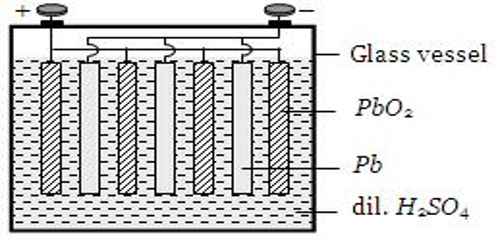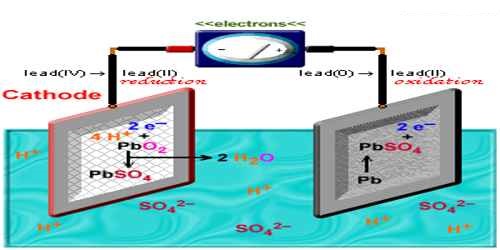Lead storage cell is a kind of Galvanic cell which is extensively used as portable sources of electrical energy in automobiles, diesel generators etc. It is named a storage cell as electricity can be stored by charging the cell over and over again. For use in the above mentioned cases a battery of cells consisting of six or more 2 V cells connected in series are used. The electrodes of the cells in a lead storage battery consist of lead grids. The openings of the anodic grid are filled with spongy (porous) lead. The openings of the cathodic grid are filled with lead dioxide (PbO2). Each cell consists of a Pb plate as one electrode and a Pb plate coated with PbO2 as another electrode. Both the plates are immersed in a 30% solution of H2SO4 of density about 1.84. The cell is-
Pb(s)│H2SO4 (aq)│PbO2 (s).Pb (s)

The Pb(s) plate and Pb(s) plate coated with PbO2 have different electrode potentials. So, when these are connected a current flows between them. The electrode reactions are:
At left electrode: Pb (s) + SO2-4 (aq) ↔ PhSO4 (s) + 2e–
At right electrode: PbO2 (s) + 4H+ (aq) + SO2-4 (aq) + 2e– ↔ PbSO4 (s) + 2 H2O (l)
The left-side electrode is anode, while the right-side electrode is cathode. The overall cell reaction is –
Pb (s) + PbO2 (s) + 2 H+ (aq) + SO2-4 (aq) ↔ discharge/charge ↔ 2 PbSO4 (s) + 2 H2O (l)
When the cell is discharging H2SO4 is consumed to produce PbSO4 and H2O. On charging the H2SO4 is regenerated. In an automobile the battery is charged by the car generator which acts as a source of e.m.f. and reserved the discharge reaction.













